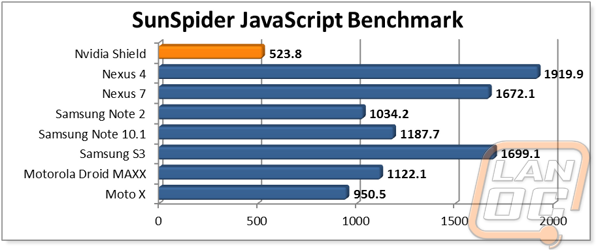Performance and Battery Life
Most people will focus on the unique design of the Shield or even its PC streaming. Even I have been guilty of it when showing it off. But when you dig into it, the Shield comes with a unique piece of hardware, the first Tegra 4 Quad Core processor. Along with that you get a few other things as well, as long as we are talking about hardware specifications. You get two gigs of RAM, 16 gigs of onboard storage and a MicroSD card slot to expand that if needed. You also get a 5 inch touchscreen with a 1280x720 resolution that folds up and out of the way. So what does all that new hardware mean for performance?
Well to find out I put the Shield through our standard mobile benchmark suite. The results…. Well let’s just take a look at them.





As you can see above, the Shield dominated in all of the benchmarks I put it through. Specifically in 3DMark where I was unable to get an Ice Storm Extreme benchmark because the device maxed out the benchmark. The SunSpider benchmark is also very impressive where the Shield ran through the benchmark in less than half the time as even the fastest devices I had previously tested. The Sunspider test went so quickly in fact that I had to triple test that I didn’t do something wrong. The new Tegra 4 processor puts the Tegra 3 and everything else tested here to shame.

For battery benchmarks I ran through the same benchmark as the other devices. Although the Shield has a large battery built in. I think its increased performance hurt the battery results. Even so, it performed up with the phones that have 48 hour battery life. Not too bad for a game console with a larger screen in my opinion.


